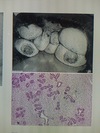Jordan's study guide- the lady bits Flashcards
Wolffian tubules
Male
Mullerian tubules
Female
Factors that determine sex
Number and type of chromosomes
Gonads
Sex hormones
Internal repro anatomy
external genitalia
3 chromosomal abnormalities
Chimerism
Klinefelter’s syndrome
Turner’s syndrome
Both male and female genitalia and both testicular and ovarian tissue
Hermaphrodite
Mismatch between gonades and genital
Pseudohermaphrodite
-named for the gonads
Female male twins
Female becomes XX/XY chimera
Most common in cattle
Blood sharing between fetuses
freemartinism
Ovarian Agenesis
missing parts
Ovarian duplication
2 on one side
Ovarian hypoplasia
Small ovaries
What ovarian condition is this

Cysts
there are many types
Piece of ovary left after removal
Ovarian remnant syndrome
Most common ovarian tumor in horses
Unilateral, large, cystic mass
Usually benign
Produce estrogen and inhibin
Granulosa (theca) cell tumor
Comparable to seminoma
Unilateral, smooth, soft
10-20% met in dogs
Aggressive in horses
Dysgerminoma
Rare neoplasia except in dogs
Arises form sub-endothelial structures
Associated with cystic endometral hyperplasia
Ascites common
Papillae indicate metastiasis
Ovarian carcinoma/adenocarcinoma
well differentiated, benign
Differentiation of 2 of the 3 germ layers
often have hair, teeth, nerves, etc

Teratoma
Blockage of fallopian tube that results in fluid accumulation
Hydrosalpinx
Fallopian tube disease primary or seconday to uterine disease
important for reproduction
Salpingitis
Piece of uterus doesn’t develop
May or may not affect fertility
Segmental aplasia
Endometritis
Commonly bacterial
Campylobacter, trtirchomonas, taylorella
ascending infection if cervix is open
What is this grade of endometritis

Grade 1
Normal
Grade of endometritis

Grade 3
Important precursor to other condition
hyperplasia of the mucosa, mucosal cysts
Hormonally regulated, leads to pyometra
cystic endometrial hyperplasia
Can be open or closed
High neutrophil count
leukamoid reaction
Pyometra





















